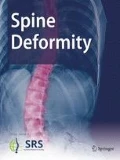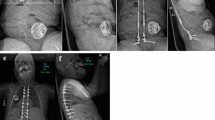Abstract
Purpose
To investigate whether intraoperative neuromonitoring (IONM) may be avoided in growing rod lengthening procedures in early onset scoliosis (EOS).
Methods
A total of 636 primary growing rod surgeries and lengthening procedures were performed in 112 patients with EOS. Traditional growing rods (TGR) or magnetically controlled growing rods (MCGR) were implanted and subsequent lengthening procedures were done at stipulated intervals. Combined multi-modality IONM was used in all index surgeries—but was only used in lengthening procedures in patients with existing spinal cord abnormality or a history of neurosurgical procedure for the same, patients with prior history of a neuromonitoring alert in their index surgery and when lengthening was accompanied by an implant exchange/revision. All the remaining growing rod lengthening procedures were carried out without IONM. Hospital records and operation notes were retrospectively reviewed with focus on details of neurological events/complications.
Results
In 112 primary growing rod applications (TGR = 96, MCGR = 16) and 524 lengthening procedures (TGR = 444, MCGR = 80), intraoperative neuromonitoring ‘alerts’ were encountered in 6/112 index surgeries and temporary postoperative neurological deficits were seen in 2/112 index surgeries. No intraoperative neuromonitoring event or postoperative neurological complication was encountered in 524 lengthening procedures—irrespective of whether they were carried out along with implant exchange, or in patients with spinal cord abnormality or prior neuromonitoring event during index surgery.
Conclusion
While IONM should be used in primary growing rod application surgeries, its use may be avoided in lengthening and implant exchange procedures in a resource-limited setting.
Level of evidence
Level 3.
Similar content being viewed by others
References
Zeltner TB, Burri PH (1987) The postnatal development and growth of the human lung. II. Morphology. Respir Physiol 67:269–282
Hell AK, Campbell RM, Hefti F (2005) The vertical expandable prosthetic titanium rib implant for the treatment of thoracic insufficiency syndrome associated with congenital and neuromuscular scoliosis in young children. J Pediatr Orthop B 14:287–293
Ahmad AA (2020) Early onset scoliosis and current treatment methods. J Clin Orthop Trauma 11:184–190
Bess S, Akbarnia BA, Thompson GH et al (2010) Complications of growing-rod treatment for early-onset scoliosis: analysis of one hundred and forty patients. JBJS 92:2533–2543. https://doi.org/10.2106/JBJS.I.01471
Mendiratta A, Emerson RG (2009) Neurophysiologic intraoperative monitoring of scoliosis surgery. J Clin Neurophysiol 26:62–69
Sala F, Dvorak J, Faccioli F (2007) Cost effectiveness of multimodal intraoperative monitoring during spine surgery. Eur Spine J 16:229–231. https://doi.org/10.1007/s00586-007-0420-0
Nandyala SV, Hassanzadeh H, Jain A, Sponseller PD (2015) Neuromonitoring in pediatric spine surgery. Semin Spine Surg 27:201–208. https://doi.org/10.1053/j.semss.2015.04.004
Akbarnia BA, Marks DS, Boachie-Adjei O et al (2005) Dual growing rod technique for the treatment of progressive early-onset scoliosis: a multicenter study. Spine 30:S46–S57
Dubousset J, Herring JA, Shufflebarger H (1989) The crankshaft phenomenon. J Pediatr Orthop 9:541–550. https://doi.org/10.1097/01241398-198909010-00008
Moe JH, Kharrat K, Winter RB, Cummine JL (1984) Harrington instrumentation without fusion plus external orthotic support for the treatment of difficult curvature problems in young children. Clin Orthop Relat Res 185:35–45
Nuwer MR, Dawson EG, Carlson LG et al (1995) Somatosensory evoked potential spinal cord monitoring reduces neurologic deficits after scoliosis surgery: results of a large multicenter survey. Electroencephalogr Clin Neurophysiol/Evok Potentials Sect 96:6–11
Sankar WN, Skaggs DL, Emans JB et al (2009) Neurologic risk in growing rod spine surgery in early onset scoliosis: is neuromonitoring necessary for all cases? Spine 34:1952–1955
Ney JP, Der Goes DNV, Watanabe JH (2012) Cost-effectiveness of intraoperative neurophysiological monitoring for spinal surgeries: beginning steps. Clin Neurophysiol 123:1705–1707
DiCindio S, Schwartz DM (2005) Anesthetic management for pediatric spinal fusion: implications of advances in spinal cord monitoring. Anesthesiol Clin N Am 23:765–787
Watanabe K, Uno K, Suzuki T et al (2013) Risk factors for complications associated with growing-rod surgery for early-onset scoliosis. Spine 38:E464–E468
Liang J, Li S, Xu D et al (2015) Risk factors for predicting complications associated with growing rod surgery for early-onset scoliosis. Clin Neurol Neurosurg 136:15–19. https://doi.org/10.1016/j.clineuro.2015.05.026
Jayaswal A, Kandwal P, Goswami A et al (2016) Early onset scoliosis with intraspinal anomalies: management with growing rod. Eur Spine J 25:3301–3307
Funding
There is no funding source for this publication/study.
Author information
Authors and Affiliations
Contributions
BG, SM, NM: concepts, design, definition of intellectual content, clinical studies, data acquisition, data analysis, manuscript preparation, manuscript editing, manuscript review and approval of final manuscript. SM, NM: literature search and statistical analysis.
Corresponding author
Ethics declarations
Conflict of interest
Dr. Bhavuk Garg, Dr Subrat Mohapatra and Dr Nishank Mehta declare that they have no conflict of interest.
Ethics approval
Approval was obtained from the ethics committee of All India Institute of Medical Sciences, New Delhi. The procedures used in this study adhere to the tenets of the Declaration of Helsinki.
Informed consent
Informed consent was obtained from all individual participants included in the study. Patients signed informed consent regarding publishing their data and photographs.
Rights and permissions
About this article
Cite this article
Garg, B., Mohapatra, S. & Mehta, N. Is routine intraoperative neuromonitoring necessary in growing rod lengthening procedures? A retrospective, observational study. Spine Deform 8, 1369–1374 (2020). https://doi.org/10.1007/s43390-020-00163-9
Received:
Accepted:
Published:
Issue Date:
DOI: https://doi.org/10.1007/s43390-020-00163-9




